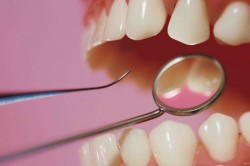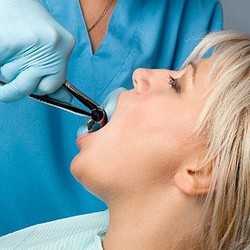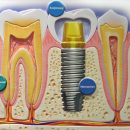In an adult person, 28-32 of the tooth is formed, 28 of them grow at an early age, the remaining four (so-called wisdom teeth) can cut off from 17 to 25 years, and sometimes much later. In their name, the teeth of wisdom are obliged to the fact that they are dispersed later than the rest of the teeth, when a person has already formed the foundations of character and worldview. In some cases, these teeth do not break, sometimes some lack of their primitives.
Features of the teeth of wisdom

The tooth of wisdom is a rear-native tooth of a person, grows the last in the dentition, and the account is eighth. Also the teeth of wisdom called «Third molars». Their dimensions usually do not exceed the average sizes of other chewing teeth.
The peculiarity of this tooth is that it immediately rubs the rootless without preparation for teething in the form of a milk tooth. The roots of the wisdom teeth have a specific shape and often twisted. The number of roots can be different, from two to three to five, sometimes several fragile roots are found.
How do wisdom teeth grow
Features of the formation and growth of wisdom teeth are due to the heredity of a particular person, the structure of its bone-jaw system, dentition. The main problem lies in reducing the jaws of a modern person compared to our distant ancestors. Often, the teuba of wisdom is not rapidly lacking places to grow on jaws, hence the difficulties arise in its placement in the dentition.
It happens that the tooth of wisdom grows incorrectly and can cause serious inconvenience, threatening with neighboring teeth, gums and even bones. This happens due to the fact that the bone tissue of the jaws has already been formed at the time of the teething, and the new tooth may not be enough space on the jaw arc.
The crown of the eighth tooth is formed up to 12 years, the teething of the tooth of wisdom begins usually not earlier than 17-18 years. The procedure for teething and the growth of third molars is sufficiently long and may be accompanied by inflammatory processes.
Problems of development of wisdom teeth

Often, pain in the field of wisdom tooth are associated with the following violations:
- Lack of place for teething tooth wisdom. Third molars grow when the gum bone tissue is already formed, and they have to pierce their way in difficult conditions. There may be various options for the crown of the teeth of wisdom, teething at various angles of inclination, lump in the direction of the cheek, horizontally in the gum, toward the neighboring tooth. The teeth of wisdom can slowly cut down inside the gums and in no way until time does not show themselves, but over time, painful sensations and not very pleasant surprises are possible. If there is a small place in the jewish arc for the normal vertical placement of the tooth of wisdom, then the development of the so-called dental crowned. The decision on medical intervention about the incorrectly developing tooth of wisdom takes a dentist based on X-ray examination. By the way, the descent of teeth of wisdom on an x-ray can be seen already at the age of 7-12 years.
- Defeating tooth wisdom caries. Third molars because of their location are difficult to accommodate for hygienic care and dental treatment. In the event of the development of caries, the tooth of wisdom can be observed painful response when entering the focus of hot or cold food, sweet, salted. Pain passes at the end of the stimulus.
- Pulp the tooth of wisdom (inflammation of the dental nerve). It is characterized by an acute pulsating bakery pain in acute pulp, or with a chronic form. Can give to the ear, neck. Pains are spontaneous character independently of external stimuli. At night, as a rule, increase. Can develop granuloma or a bastard cyst.
- Periodontitis tooth of wisdom (inflammation of near-free fabrics). Characteristic pain, when pressed to the tooth and tapping, pain is enhanced. From the side of the tooth there is a swelling of gums and / or cheeks, a fistula on the gum may be present.
- Pericoronite (or pericoroid) - a fairly common complication during the teething of wisdom. The soft tissues of the gums in the region of the teething or cutting tooth are inflamed, while the so-called inflammation may appear in the focus of inflammation «Hood». An unpleasant taste and smell of mouth appear, the process is accompanied by pains, edema in the area of the gums, painful sensations in pricing and swallowing, as well as increase in temperature. It is possible to assign the course of antibiotics to relieve inflammation, as well as the removal of the hood or the removal of the tooth of wisdom.
Teeth wisdom - delete or treat?

In the presence of problems with wisdom teeth, as a rule, medical dental intervention, a therapeutic or surgical nature is required. For therapeutic treatment apply:
- Anti-inflammatory drugs and removal Edeys;
- aseptic, antibacterial drugs;
- Anesthetics.
Either need surgical intervention. The dentist doctor assesses the destruction of the tooth of wisdom, the availability of indications for its preservation and treatment or removal:
- In some cases, in the absence of one or two neighboring teeth, in the future the third molar may be needed for prosthetics (a non-removable pavement prosthesis is attached to it).
- If the tooth of wisdom occupies a normal vertical position in the jewish arc and participates in chewing, while he has a tooth antagonist (symmetrical tooth of wisdom on the opposite top or bottom of the jaw), then such a tooth is advisable to try to keep such a tooth. When one of the antagonists is removed, there is a possibility of extending a symmetric tooth from the jaw (due to the lack of load), and its subsequent loss.
- The pulpit or cyst of the tooth of wisdom - in the presence of access to the root canals of the tooth and a qualitatively conducted treatment, such a tooth can be saved.
Before the visit to the dentist

You can use proven to facilitate pain and inflammation:
- attached to the outer side of the cheek in the area of the patient's tooth cold (ice);
- To remove inflammation rinse mouth with warm water with soda or salt, grasses champs (chamomiles, sage, Calendula), aseptic solutions (Chlorhexidine, Eludril);
- adopt anti-inflammatory and painkillers (paracetamol, nimesulide, ibuprofen, analgin and t.NS.).
Even after removing the symptoms of dental pain, our site strongly recommends contacting the dentist. Depending on the state of the tooth, treatment will be assigned or, if necessary, delete. The desire to keep the tooth in the case of the teeth of wisdom is not always justified. Doctor explain in detail the treatment regimen or surgery.









